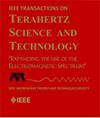太赫兹应用中径向SWS的分析建模、仿真和冷测试
IF 3.9
2区 工程技术
Q2 ENGINEERING, ELECTRICAL & ELECTRONIC
IEEE Transactions on Terahertz Science and Technology
Pub Date : 2025-07-03
DOI:10.1109/TTHZ.2025.3585674
引用次数: 0
摘要
本文介绍了用于太赫兹应用的径向慢波结构的分析设计、仿真和冷试验验证,解决了传统轴向设计的局限性。径向真空电子器件增强了相互作用面积,减少了空间电荷效应,并实现了紧凑、无磁场的操作,使其非常适合于高功率太赫兹源。建立了一个数学框架,推导了径向结构的色散方程,并进行了数值模拟,分析了色散特性、外部质量因子和相互作用阻抗。设计了一个径向后向波振荡器(BWO)来验证0.65太赫兹的解析模型。通过粒子池模拟来评估其性能,该模拟模拟了发散径向片状电子束与电磁波之间的相互作用。粒子模拟证实了径向BWO在没有外部磁场的情况下工作,在0.651太赫兹下,使用20.2 kv, 400 ma的电子束实现了46.4 W的峰值输出功率。设计了一种匹配的tem - te_bb_0模式转换器,以有效地提取实际应用中的射频功率。所提出的BWO由40个周期和一个集成模式转换器组成,具有精确的表面处理、尺寸精度和与太赫兹操作要求的兼容性。用模态变换器对BWO进行冷态测试,结果表明,在期望频率下,S$_{11}$参数约为- 13 dB,与仿真结果非常吻合。这些发现突出了径向BWO作为紧凑、高功率太赫兹源的潜力,为高级应用提供了稳定、高效的运行。本文章由计算机程序翻译,如有差异,请以英文原文为准。
Analytical Modeling, Simulation, and Cold Testing of a Radial SWS for THz Applications
This article presents the analytical design, simulation, and cold-test validation of a radial slow-wave structure for terahertz applications, addressing the limitations of conventional axial designs. Radial vacuum electron devices enhance the interaction area, reduce space charge effects, and enable compact, magnetic field-free operation, making them well-suited for high-power THz sources. A mathematical framework is developed to derive dispersion equations for the radial configuration, and numerical simulations to analyze the dispersion characteristics, external quality factor, and interaction impedance. A radial backward wave oscillator (BWO) is designed to validate the analytical model at 0.65 THz. Its performance is evaluated through particle-in-cell simulations, which model the interaction between the diverging radial sheet electron beam and the electromagnetic wave. The particle simulation confirms that the radial BWO operates without an external magnetic field, achieving a peak output power of 46.4 W at 0.651 THz using a 20.2-kV, 400-mA electron beam. A matched TEM-TE$_{10}$ $_{11}$
求助全文
通过发布文献求助,成功后即可免费获取论文全文。
去求助
来源期刊

IEEE Transactions on Terahertz Science and Technology
ENGINEERING, ELECTRICAL & ELECTRONIC-OPTICS
CiteScore
7.10
自引率
9.40%
发文量
102
期刊介绍:
IEEE Transactions on Terahertz Science and Technology focuses on original research on Terahertz theory, techniques, and applications as they relate to components, devices, circuits, and systems involving the generation, transmission, and detection of Terahertz waves.
 求助内容:
求助内容: 应助结果提醒方式:
应助结果提醒方式:


